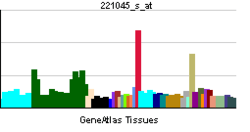PER3
| Period circadian clock 3 | |||||||||||||
|---|---|---|---|---|---|---|---|---|---|---|---|---|---|
| Identifiers | |||||||||||||
| Symbols | PER3 ; GIG13 | ||||||||||||
| External IDs | OMIM: 603427 MGI: 1277134 HomoloGene: 7886 GeneCards: PER3 Gene | ||||||||||||
| |||||||||||||
| RNA expression pattern | |||||||||||||
 | |||||||||||||
| More reference expression data | |||||||||||||
| Orthologs | |||||||||||||
| Species | Human | Mouse | |||||||||||
| Entrez | 8863 | 18628 | |||||||||||
| Ensembl | ENSG00000049246 | ENSMUSG00000028957 | |||||||||||
| UniProt | P56645 | O70361 | |||||||||||
| RefSeq (mRNA) | NM_001289861 | NM_001289877 | |||||||||||
| RefSeq (protein) | NP_001276790 | NP_001276806 | |||||||||||
| Location (UCSC) | Chr 1: 7.84 – 7.91 Mb | Chr 4: 151 – 151.04 Mb | |||||||||||
| PubMed search | |||||||||||||
The PER3 gene encodes the period circadian protein homolog 3 protein in humans.[1]
This gene is a member of the Period family of genes and is expressed in a circadian pattern in the suprachiasmatic nucleus, the primary circadian pacemaker in the mammalian brain. Genes in this family encode components of the circadian rhythms of locomotor activity, metabolism, and behavior. Circadian expression in the suprachiasmatic nucleus continues in constant darkness, and a shift in the light/dark cycle evokes a proportional shift of gene expression in the suprachiasmatic nucleus. The specific function of this gene is not yet known.[2]
See also
References
- ↑ Shearman LP, Zylka MJ, Weaver DR, Kolakowski LF Jr, Reppert SM (Jan 1998). "Two period homologs: circadian expression and photic regulation in the suprachiasmatic nuclei". Neuron 19 (6): 1261–9. doi:10.1016/S0896-6273(00)80417-1. PMID 9427249.
- ↑ "Entrez Gene: PER3 period homolog 3 (Drosophila)".
Further reading
External links
- PER3 protein, human at the US National Library of Medicine Medical Subject Headings (MeSH)
This article incorporates text from the United States National Library of Medicine, which is in the public domain.
| ||||||||||||||||||||||||||||||||||||||||||||||||||||||||||||||||||||||||||||||||||||||||||||||||||||||||||||||||||||||||||||||||||||||||||||||||||||||||||||||||||||||||||||||||||||||||||||||||||||||||||||||